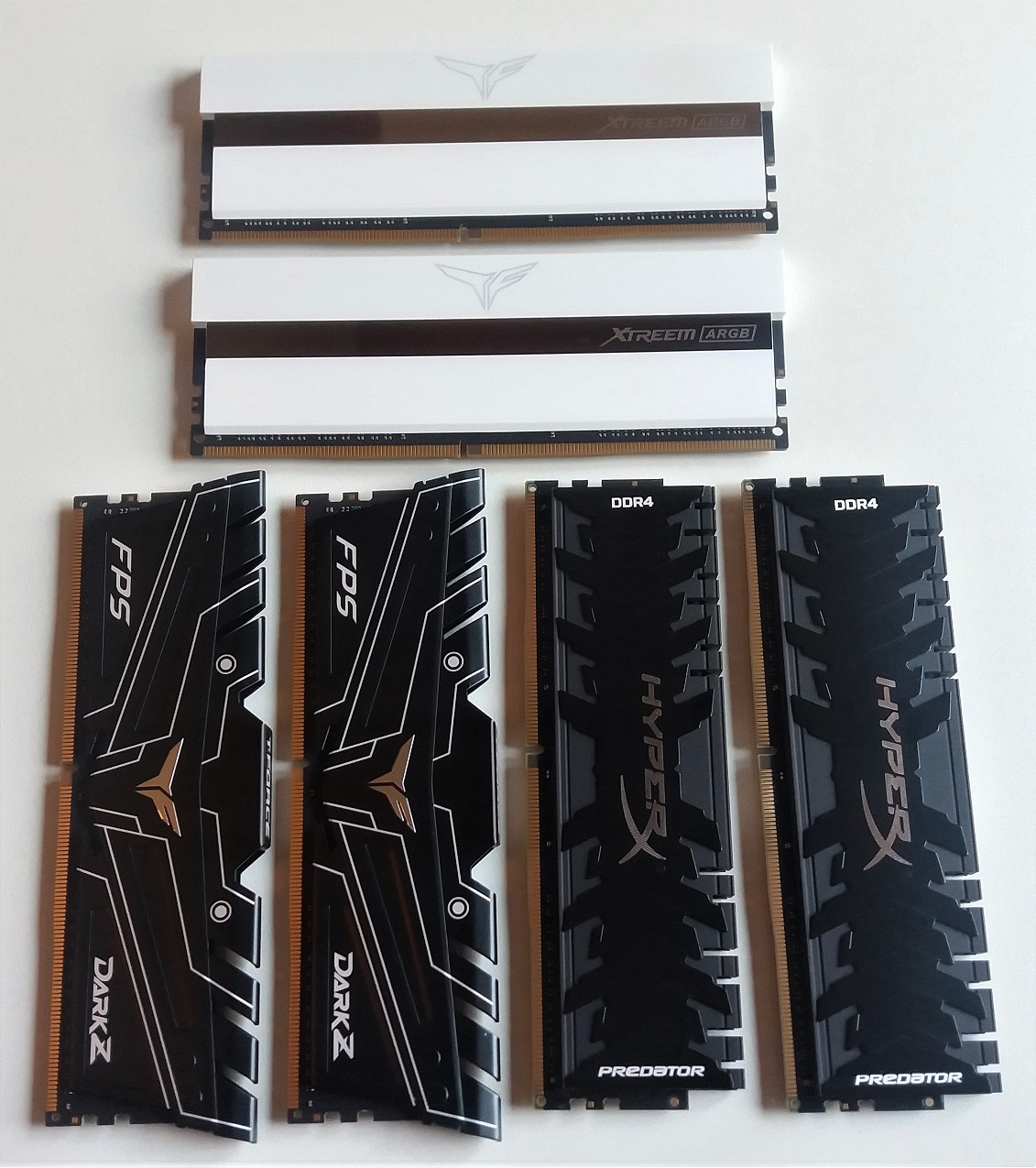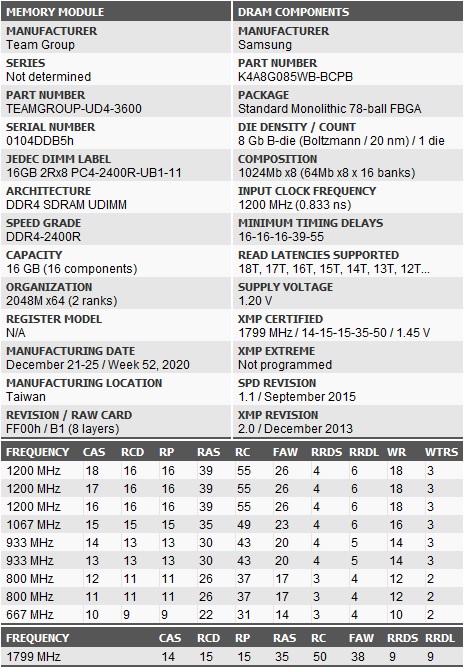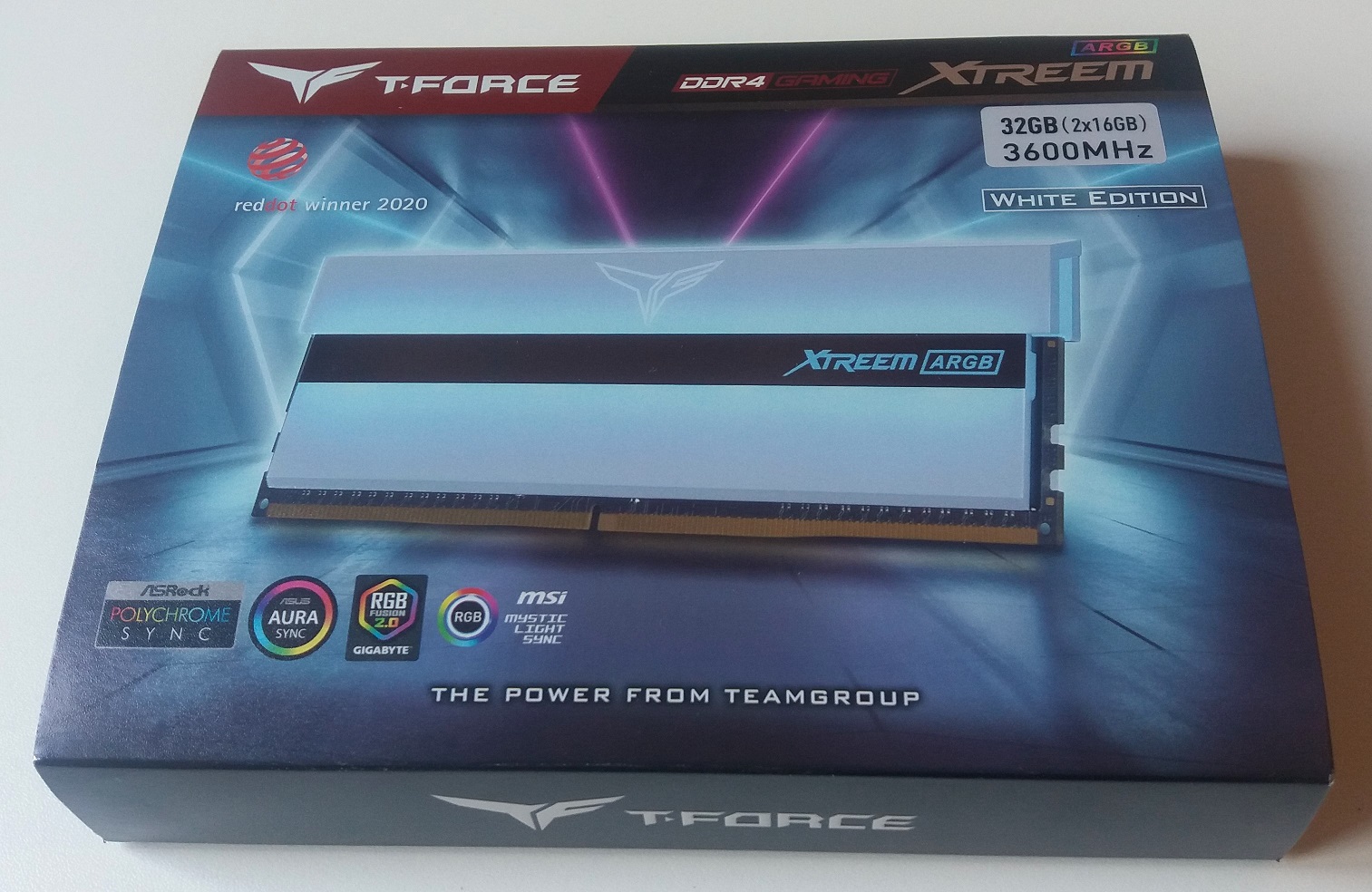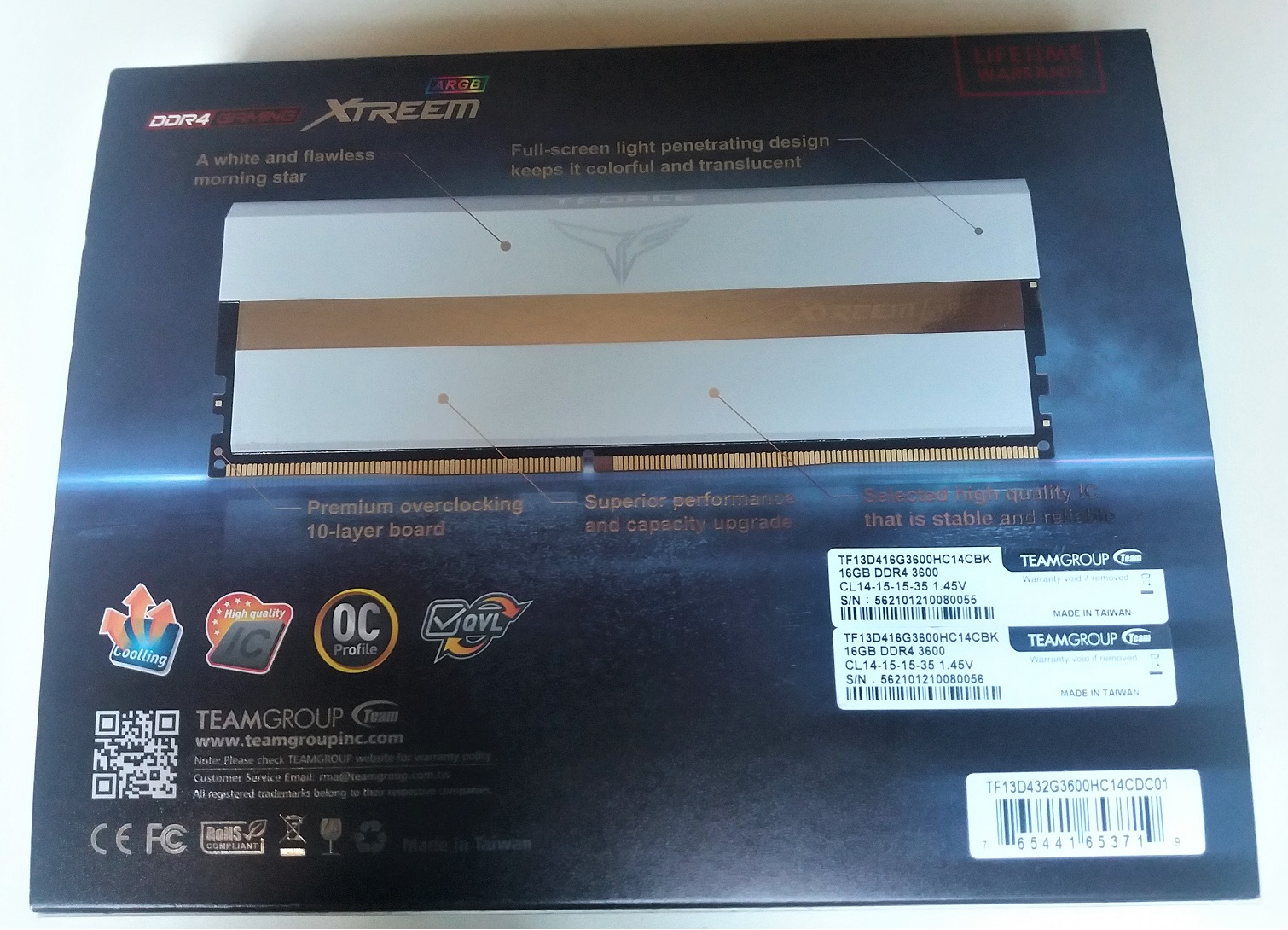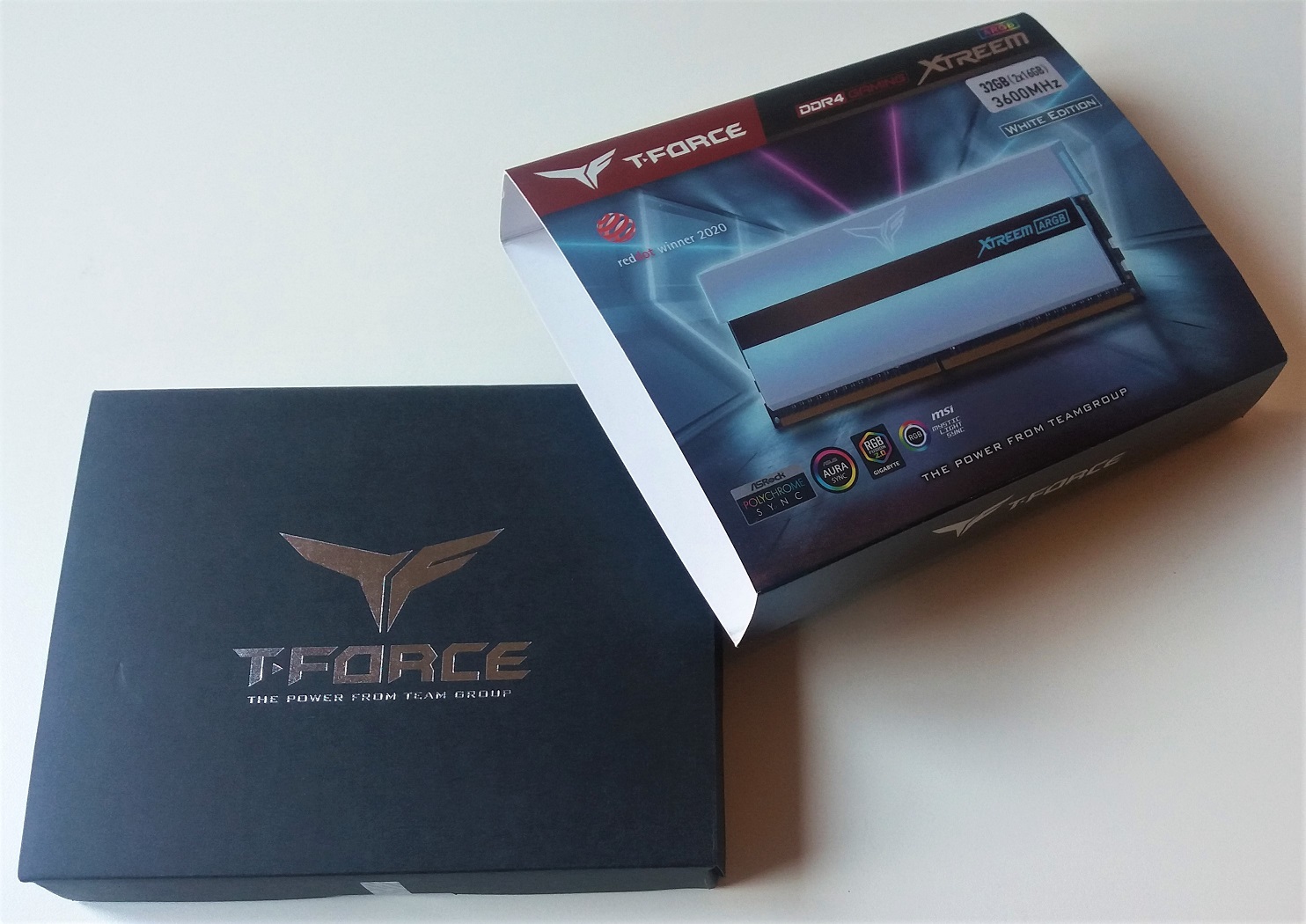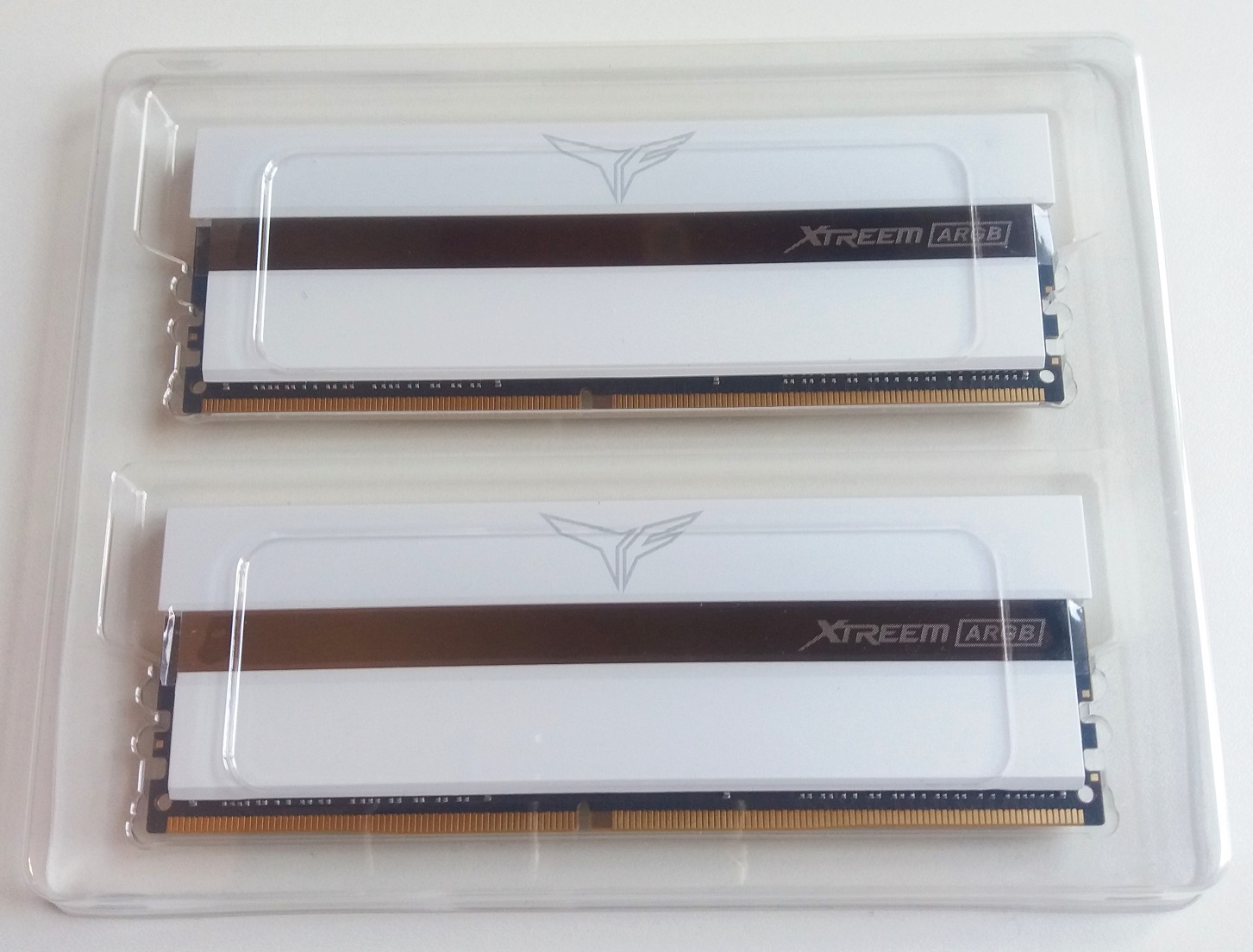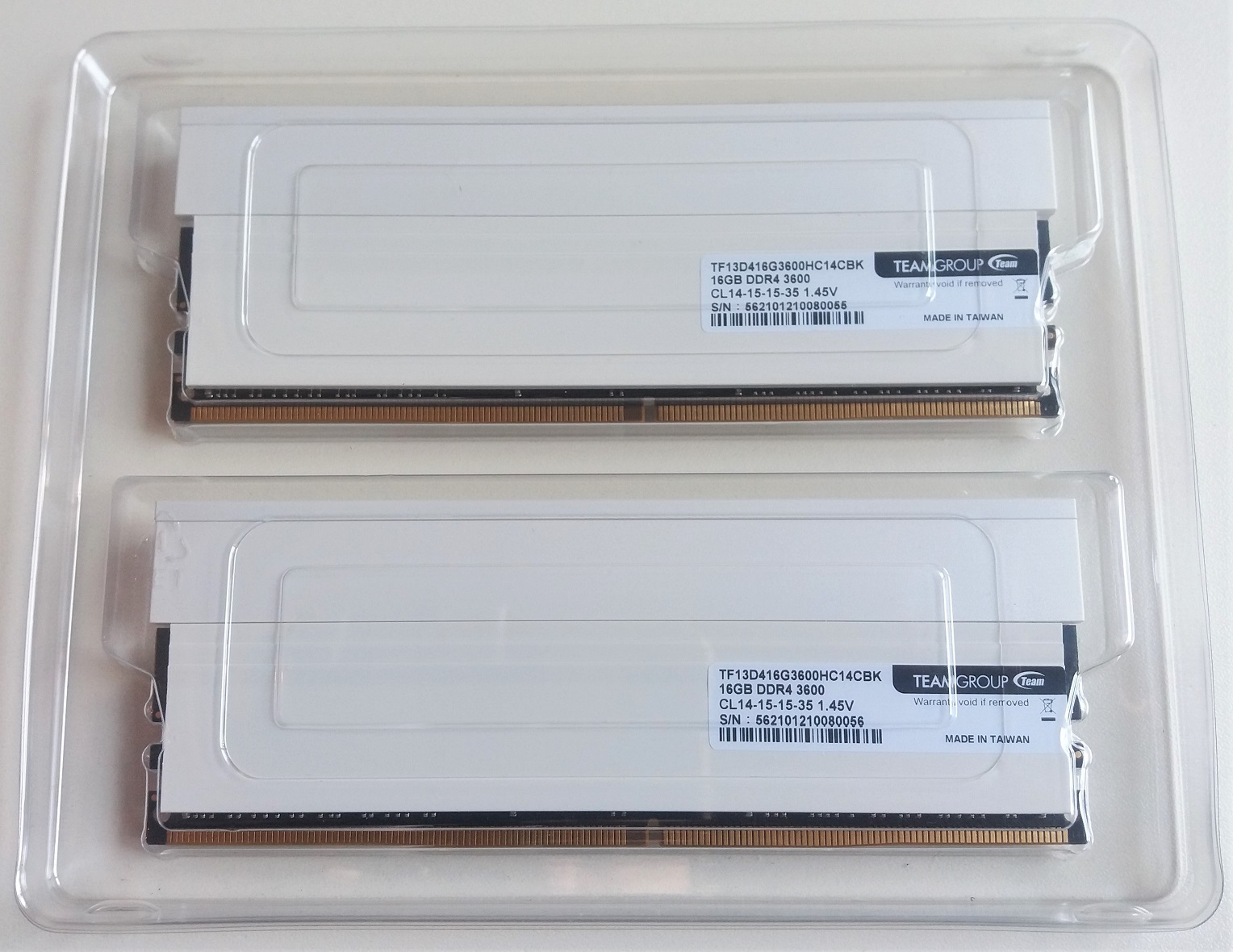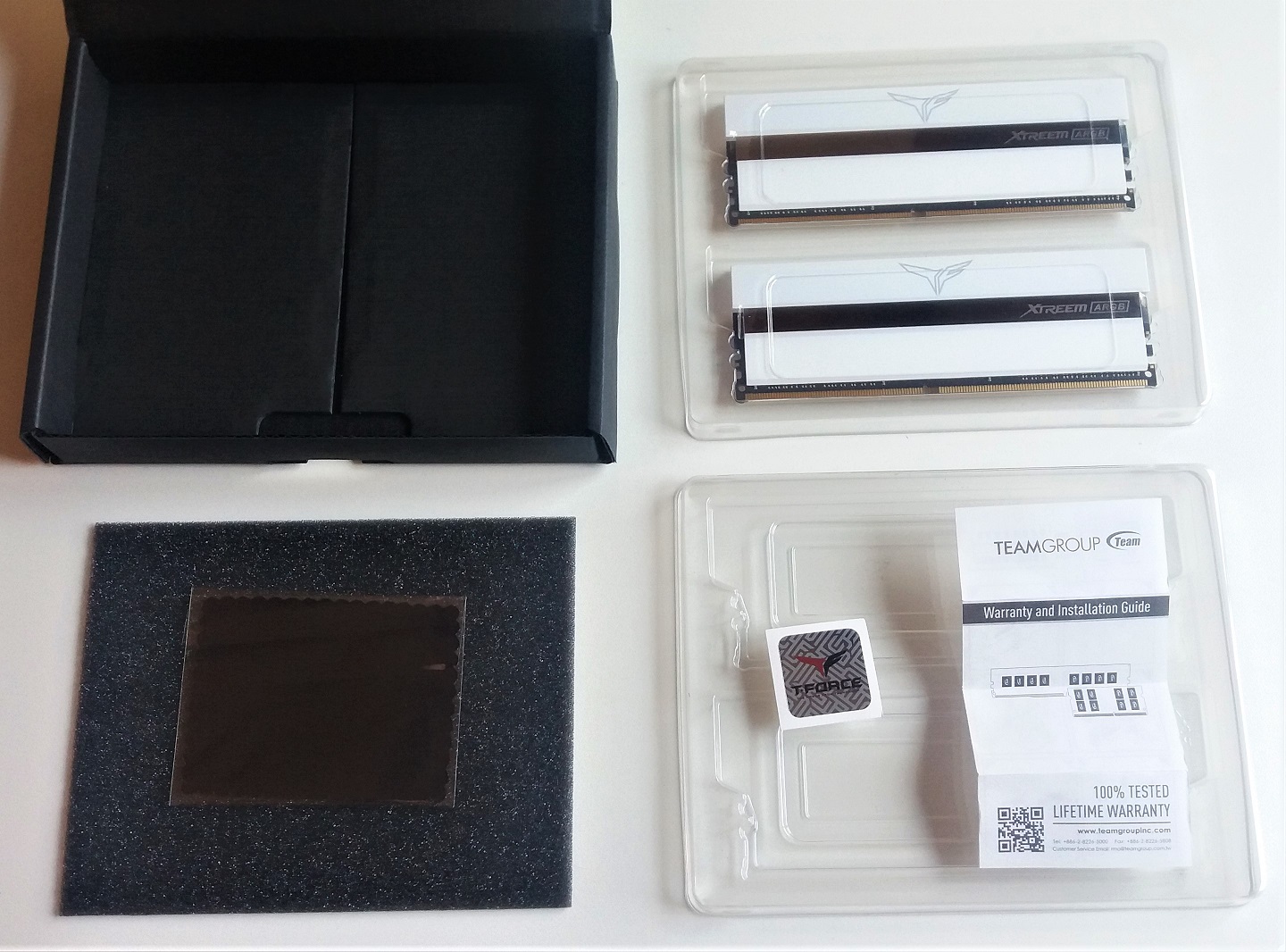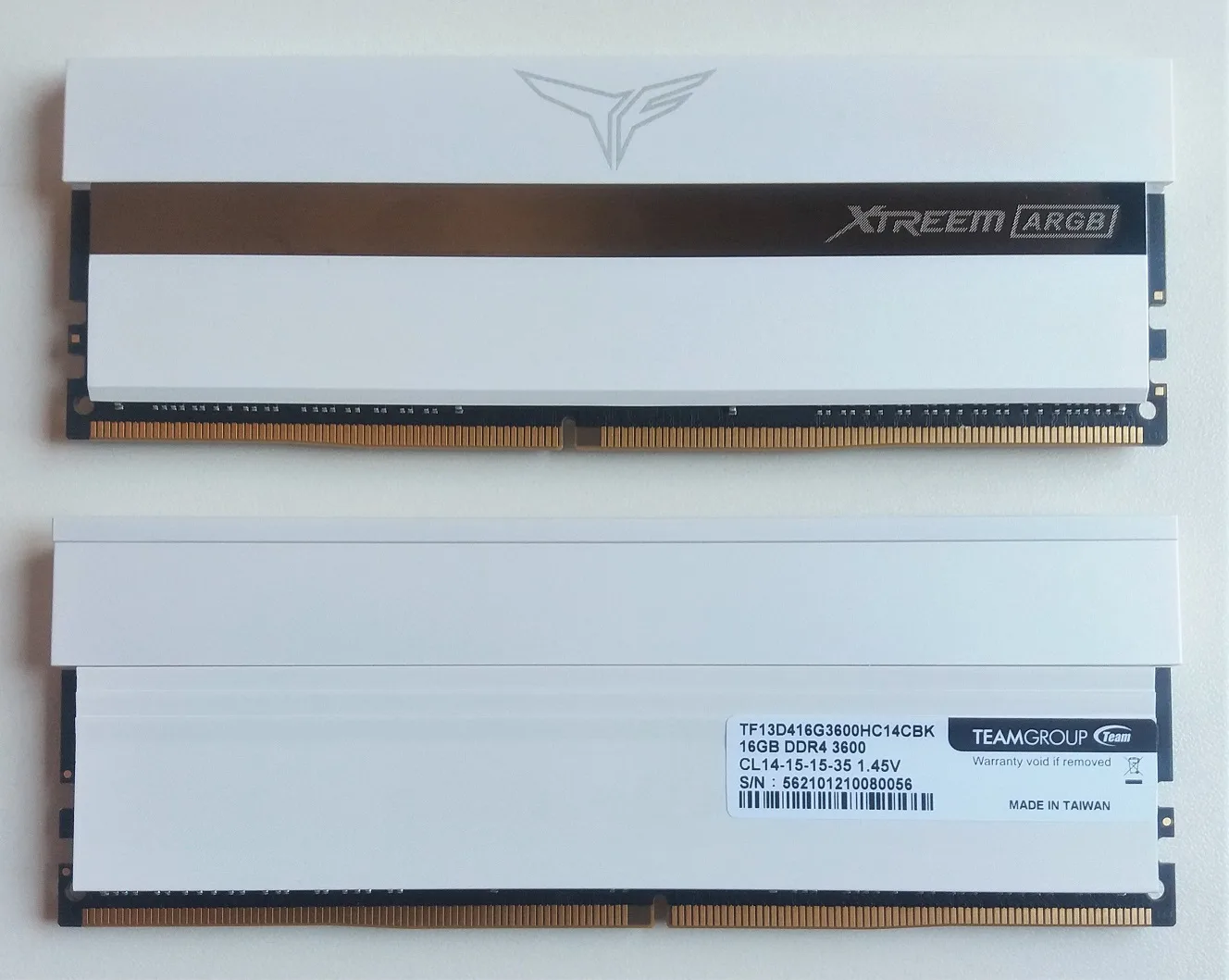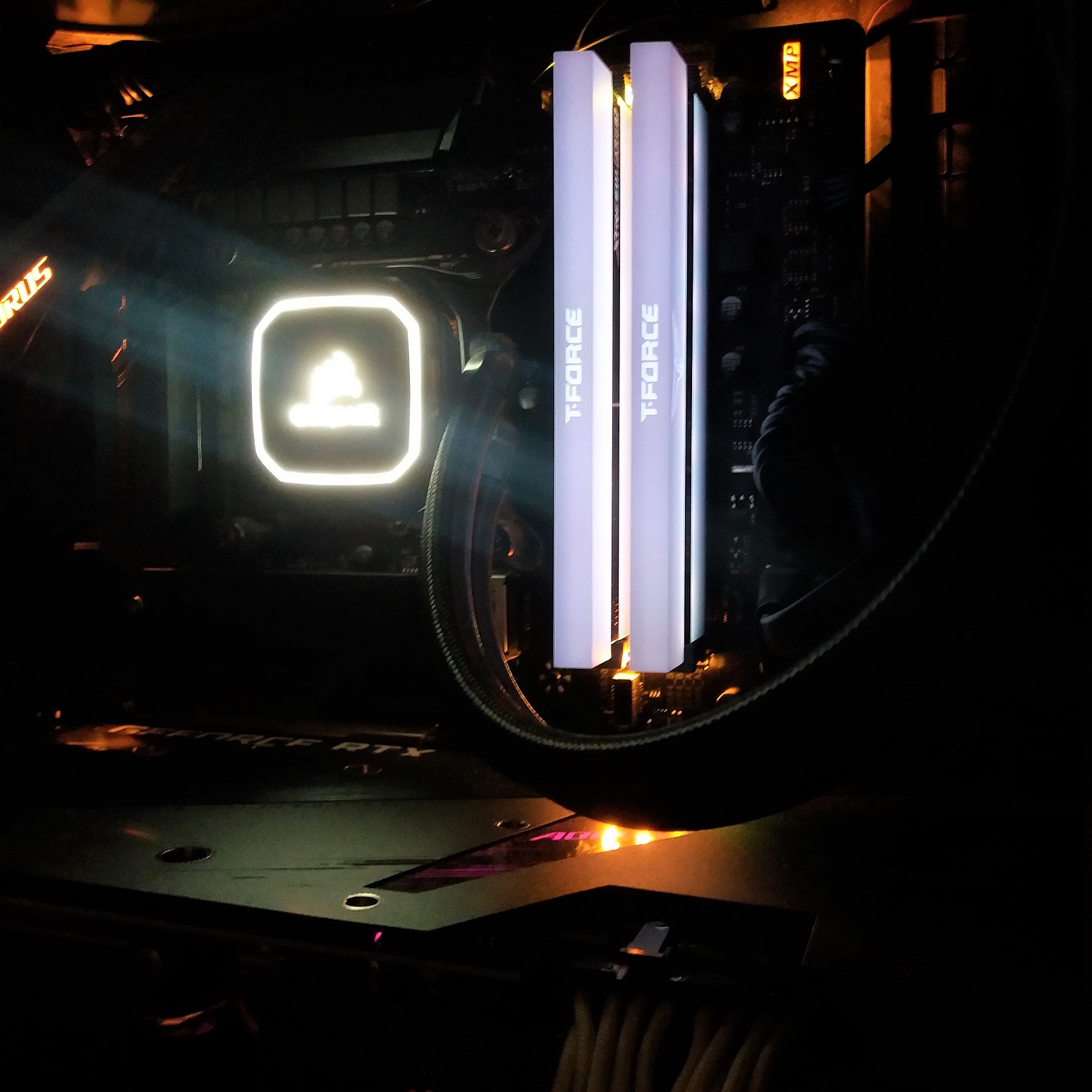TeamGroup T-FORCE XTREEM ARGB WHITE DDR4-3600MHz CL14 2x16GB Kit Review — In Search of Its Limit on an i9-9900K/Z390 Platform
T-FORCE XTREEM ARGB WHITE DDR4-3600MHz is a premium fast 2x16GB gaming memory kit that we are reviewing to see how high its frequency can go on an i9-9900K/Z390 platform. We received a review sample from TeamGroup, who told us they could not assure it can reach the advertised 3600MHz frequency on our CPU platform. We will search for its maximum stable and safe overclock and compare its performance against both its default JEDEC specifications (non-XMP) and our Kingston HyperX Predator DDR4-3333MHz 2x16GB memory kit.
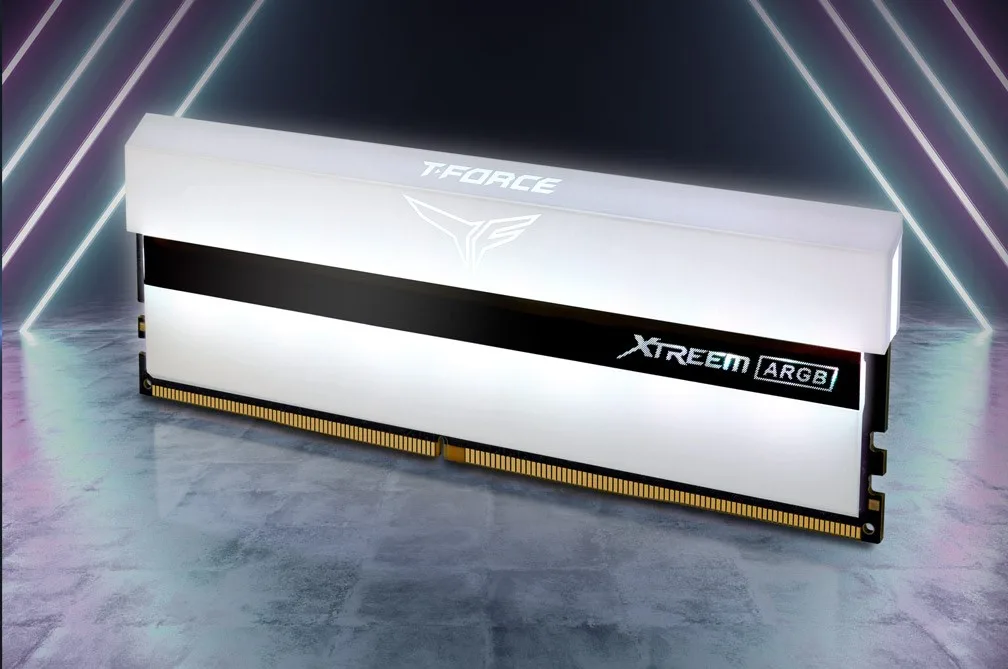
Our usual benchmarking PC features 2x16GB of HyperX Predator DDR4 CAS Latency (CL) 16 memory at 3333MHz (XMP profile 1). We will also chart performance data for our previously reviewed DARK Z FPS 2x8GB memory kit overclocked at 3600MHz only as a reference and check if the XTREEM ARGB WHITE DDR4 memory kit is a good upgrade for our current testing setup.
Here are the three memory kits that we are comparing:
- TeamGroup T-FORCE XTREEM ARGB WHITE PC4-28800 DDR4-3600MHz CL14 2x16GB kit
- Kingston HyperX Predator PC4-26700 DDR4-3333MHz CL16 2x16GB kit
- TeamGroup T-FORCE DARK Z FPS PC4-32000 DDR4-4000MHz CL16 2x8GB kit
The T-FORCE XTREEM ARGB WHITE DDR4-3600 CL14 2x16GB kit MSRP is $359.99, but it is currently out of stock in the USA. However, it is currently available on Amazon.es (the price is in Euros).
Testing Platform
Our testing platform is a recent clean install of Windows 10 Pro 64-bit, using an Intel Core i9-9900K at stock settings, a Gigabyte Z390 AORUS PRO motherboard, a Samsung 500GB 960 EVO NVMe M.2 and WD Blue 1TB SATA SSDs, and 32GB T-FORCE XTREEM ARGB WHITE DDR4-3600MHz, 16GB T-FORCE DARK Z FPS DDR4-4000MHz, or 32GB HyperX Predator DDR4-3333MHz. We used the Gigabyte AORUS RTX 3080 MASTER at stock clocks for our testing. The settings, benchmarks, and hardware are identical except for the three DDR4 kits and frequencies we compare.
The Command Rates of these three memory kits are 2T by their respective default XMP profiles. The T-FORCE XTREEM ARGB WHITE is rated at CL14-15-15-35 and 1.45V using its XMP profile, the T-FORCE DARK Z FPS is CL16-18-18-38 and 1.45V using its XMP profile, and the HyperX Predator is CL16-18-18-36 and 1.35V (XMP profile 1).
This time, we will compare and calculate the performance gains or losses of the T-FORCE XTREEM ARGB WHITE versus HyperX Predator DDR4 kits and overclock the XTREEM ARGB WHITE memory to chart the effects of different memory speeds on the performance of 5 modern PC games, including Call of Duty Warzone and PLAYERUNKNOWN’S BATTLEGROUNDS (PBUG) at a maxed-out/ultra 1920×1080 resolution. We benchmark using multiple well-respected memory-related benchmarking tools such as AIDA64, Sandra, Cinebench, and 3DMark.
Product Specifications & Features
Here are the memory specifications of the XTREEM ARGB WHITE DDR4-3600MHz from the TeamGroup website:
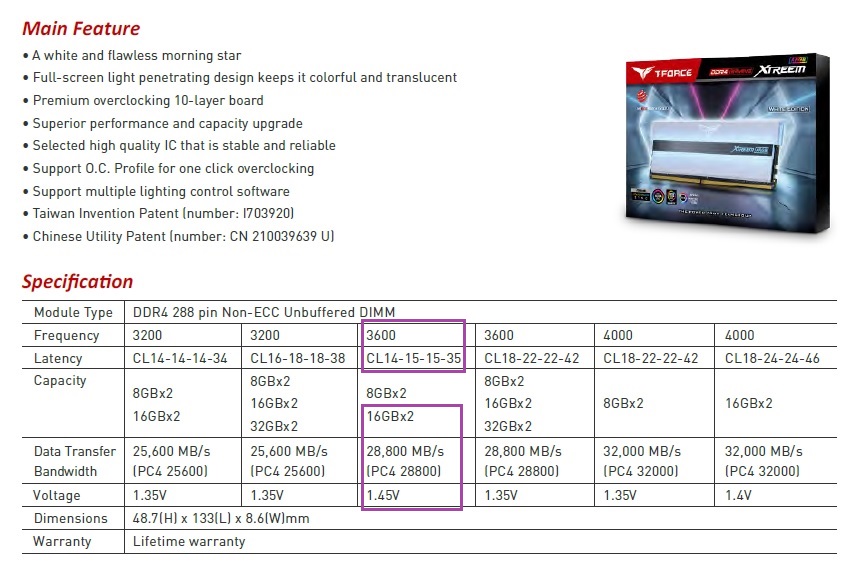
Below you can also see a summary of the memory specifications from the Thaiphoon Burner tool:
Using its default XMP profile, the voltage is automatically set at 1.45V for 3600MHz but may be manually adjusted in the BIOS from between 1.20V to 1.50V – or higher. Here are the XTREEM ARGB WHITE features as taken from TeamGroup’s website.
Features
- A white and flawless morning star
- Full-screen light penetrating design keeps it colorful and translucent
- Premium overclocking 10-layer board
- Superior performance and capacity upgrade
- Selected high-quality IC that is stable and reliable
- Support O.C. Profile for one-click overclocking
- Support multiple lighting control software
TeamGroup offers a lifetime warranty for their T-FORCE desktop memory, and XTREEM ARGB WHITE is available only in white.
Let’s unbox the memory kit on the next page and take a closer look.
Unboxing
The T-FORCE XTREEM ARGB WHITE DDR4 3600MHz 2x16GB memory kit comes in a robust cardboard box covered by great artwork that advertises its features and specs on its reverse.
Once you open the cardboard box, you see the two memory modules inside an anti-static plastic clamshell.
Below you can see both sides of the plastic clamshell and its content.
The cardboard box also includes a small soft cloth for cleaning the central strip of the modules and an additional plastic clamshell, which works as a support or base for the other clamshell with the memory modules, and which contains the warranty/installation guide and a sticker with the T-FORCE logo.
Below you can see a photo showing both sides of the memory modules.
The XTREEM ARGB WHITE DDR4-3600MHz modules feature a premium and high-quality build, a clean full-screen light penetrating design, and it looks stunning once installed in our conservative and non-RGB-focused gaming rig.
Before offering the performance data and charts of each different analysis scenario, it’s important to describe both the hardware and software configuration used in our testing, as well as the analysis methodology.
Benchmarking Methodology
Test Configuration – Hardware
- Intel Core i9-9900K (Hyper-Threading/Turbo boost on; stock settings)
- Gigabyte Z390 AORUS PRO motherboard (Intel Z390 chipset, v.F12l BIOS)
- TeamGroup T-FORCE XTREEM ARGB WHITE PC4-28800 DDR4-3600MHz CL14 2x16GB kit
- Kingston HyperX Predator PC4-26700 DDR4-3333MHz CL16 2x16GB kit
- TeamGroup T-FORCE DARK Z FPS PC4-32000 DDR4-4000MHz CL16 2x8GB kit
- Gigabyte AORUS GeForce RTX 3080 MASTER 10GB (rev. 1.0); v.F4 VBIOS, stock clocks
- Samsung 500GB SSD 960 EVO NVMe M.2
- WD Blue 1TB SATA SSD
- Corsair RM750x, 750W 80PLUS Gold power supply unit
- ASUS TUF Gaming VG289Q 28? IPS UltraHD (3840×2160) 60Hz 5ms FreeSync Monitor (Fixed Refresh Rate On)
Test Configuration – Software
- NVIDIA GeForce 466.77 drivers; ‘High Quality’ and ‘prefer maximum performance’ (on a per-game profile-basis); fixed refresh rate (globally).
- Resizable BAR off.
- V-Sync application controlled in the control panel, V-Sync off in-game.
- AA and AF as noted in games; all in-game settings are specified.
- Windows 10 64-bit Pro edition, latest updates v21H1, High-performance power plan, HAGS off, Game Mode, Game DVR & Game Bar features off.
- Gigabyte and ASUS tools not installed.
- Latest DirectX
- All 5 games are patched to their latest versions at the time of publication.
- AIDA64 Extreme, the latest version
- CapFrameX (CX), the latest version
- Cinebench R23
- CPU-Z, the latest version
- ISLC (Purge Standby List) before each benchmark.
- Karhu RAM Test
- OCCT, the latest version
- RivaTuner Statistics Server (RTSS), the latest version
- SiSoftware Sandra Tech Support (Engineer) 2021, the latest version
- Thaiphoon Burner, the latest version
- UL 3DMark’s benchmark suite, the latest version
GeForce Driver Suite-related
- Standard Game Ready drivers are used.
- The display driver is installed.
- The latest version of PhysX is installed.
Synthetic & Hybrid Tests-related
- Single run per test.
Game Benchmarks-related
- We use the corresponding built-in or custom benchmark sequence.
Frametimes Capture & Analysis tool-related
- CapFrameX is used for capturing and analyzing the relevant performance numbers obtained from each recorded built-in or custom game benchmark sequence.
- Consecutive runs until detecting 3 valid runs (no outliers) that can be aggregated by CapFrameX using the following method:
- ‘Aggregate excluding outliers’:
- Outlier metric: Third, P0.2 (0.2% FPS percentile).
- Outlier percentage: 3% (the % the FPS of an entry can differ from the median of all entries before counting as an outlier).
- ‘Aggregate excluding outliers’:
- We compare and value the results and aggregated records in terms of percentages of gain/loss, by setting the following thresholds to consider a certain % value as significant (not within the margin of error) for our benchmarking purposes:
- Metric/Score > 3% when valuing synthetic and hybrid benchmarks;
- FPS Avg > 3% when valuing raw performance in games.
Benchmark Suite: 5 PC Games, 8 Synthetic & 3 Hybrid Memory-Related Tests
Synthetic Tests
- AIDA64 Memory benchmarks:
- Copy
- Latency
- Read
- Write
- Sandra 2021 Memory benchmarks:
- Overall Score
- Memory Bandwidth
- Memory Latency
- Transaction Throughput
Hybrid Tests
- Cinebench R23:
- CPU Score
- 3DMark Fire Strike:
- Physics Score
- Combined Score
DX11 Games
- Far Cry New Dawn (DX11)
- PLAYERUNKNOWN’S BATTLEGROUNDS (PUBG) DX11
DX12 Games
- Call Of Duty Warzone (DX12)
- Metro Exodus (DX12)
- Watch Dogs Legion (DX12)
NVIDIA Control Panel settings
Here are the global NVIDIA Control Panel settings:
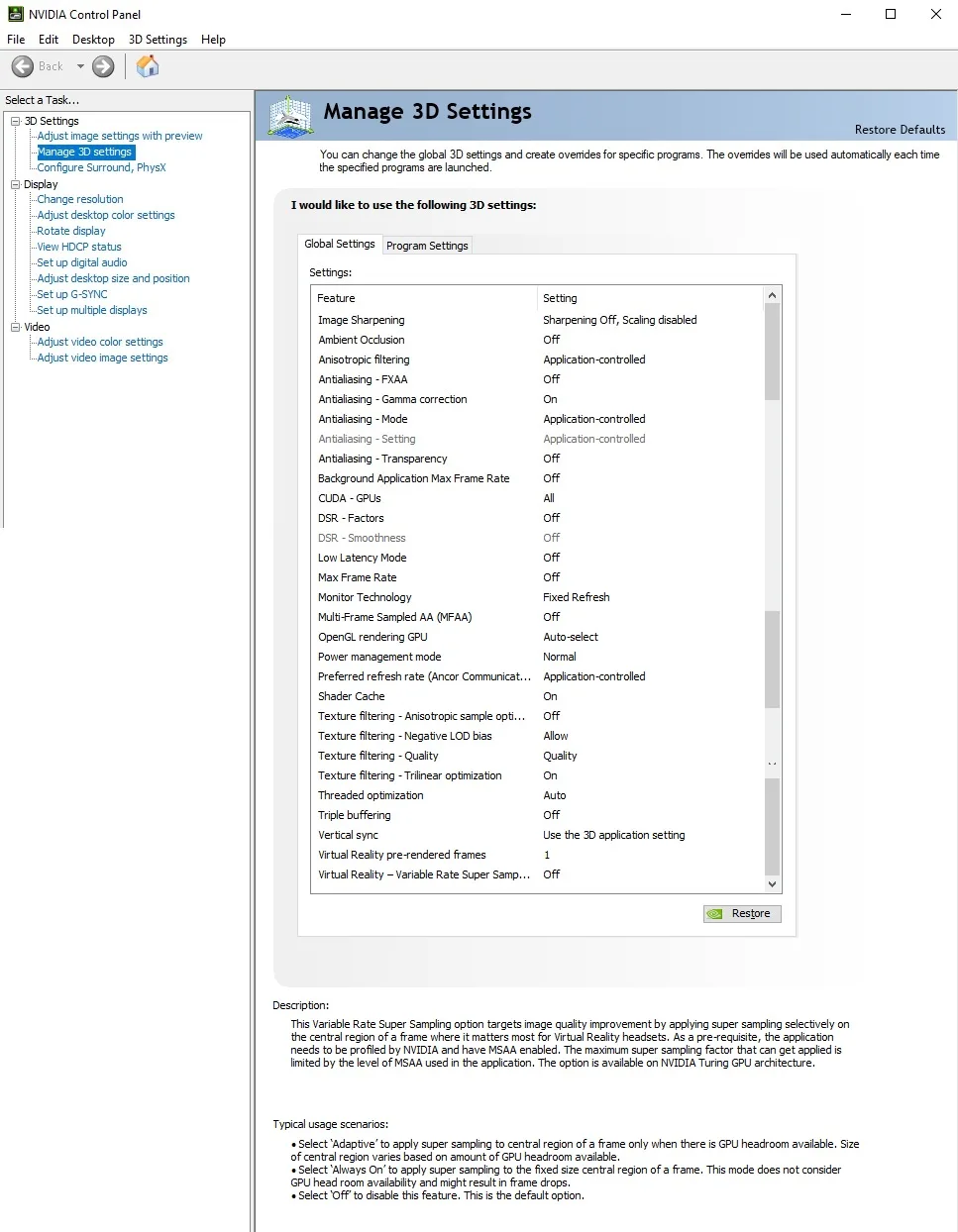
Both ‘High-Quality’ values for texture filtering-quality setting and ‘Prefer maximum performance’ for power management mode are set on a per-game or program profile-basis via Manage 3D Settings > Program settings tab.
Let’s head to our overclocking and benchmarking results.
Overclocking the T-FORCE XTREEM ARGB WHITE DDR4-3600MHz CL14 2x16GB Kit
Before accepting the XTREEM ARGB WHITE 2x16GB DDR4-3600MHz CL14 memory kit for review, TeamGroup warned us that they do not guarantee the rated XMP frequency of 3600MHz on our Z390 CPU platform. So, we were asked to investigate how high the frequency can go on our Z390 platform, and we gladly accepted their proposal.
XTREEM ARGB WHITE 3600MHz XMP Profile
First, we tried the XTREEM ARGB WHITE 3600MHz 14-15-15-35 at 1.45V using its XMP profile, but we can confirm this isn’t a viable option on our CPU platform. We enabled the XMP profile through our UEFI BIOS, but our system systematically either refused to POST or automatically reverted to default JEDEC specs. So, we decided to use a manual memory overclock approach.
XTREEM ARGB WHITE Manual Overclock
We used the XTREEM ARGB WHITE default XMP timings and reduced its clocks from 3600MHz until we reached its maximum stable speed at 1.450V.
As we aim for the highest stable overclock that the XTREEM ARGB WHITE memory can reach on our Z390 platform, we use the stock XMP primary timings and voltage, applying the Enhanced Performance memory profile for the secondary and tertiary timings through our BIOS.
Here is CPU-Z showing the XTREEM ARGB WHITE’s default JEDEC and XMP profile timings and frequencies:
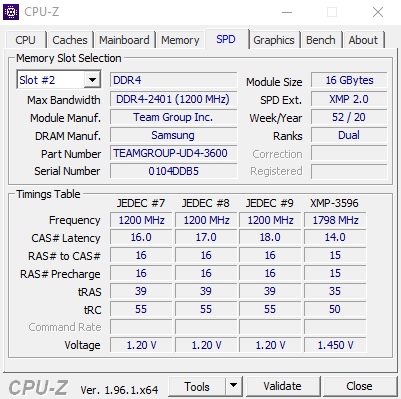
Below is the XTREEM ARGB WHITE operating at its default 2400MHz JEDEC specifications:
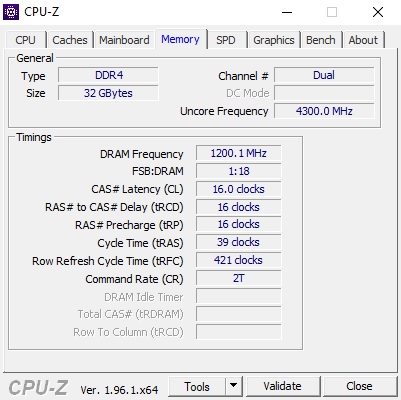
Here is the XTREEM ARGB WHITE manually overclocked to 3200MHz with CL14-15-15-35 timings at 1.450V for stability:

We used our own self-imposed hard limit of 1.450V to stabilize the memory overclock. After much trial and error, we finally settled on a maximum stable overclock of 3200MHz.
We tested our overclock by using AIDA64 System Test, Karhu RAM Test, and OCCT Memory Test. These tests stress the memory and also the CPU in search of memory errors. We also confirmed that our overclock to 3200MHz was stable by playing games and running other benchmarks.
We believe that overclocking +800MHz from JEDEC-2400MHz specs to 3200MHz CL14-15-15-35 @1.450V may be a good overclock for Z390 users wanting safe daily use, stability, and high performance.
Next, the summary charts and performance notes.
Intel Z390 Performance Results
Below you can find the summary charts of our representative selection of 5 PC games and 8 synthetic and 3 hybrid benchmarks. We select games that are CPU-dependent and use a display resolution that makes them overall more CPU-bound.
You can see the list of games’ graphics settings on the charts, and we run each built-in or custom game benchmark’s sequence at 1920×1080 (Full HD). You may click on each chart to open a pop-up for the best viewing.
We mark significant performance changes (higher than 3%) in bold and use purple or orange font for the significant improvements or regressions respectively.
Synthetic & Hybrid Summary Charts




Performance Summary Charts with 5 Games

Notes on T-FORCE XTREEM ARGB WHITE DD R4-3600MHz Performance
From the charts, we see significant score improvements between the default XTREEM ARGB WHITE 2400MHz JEDEC profile and our custom XTREEM ARGB WHITE 3200MHz OC profile in most synthetic and hybrid memory-related tests. When we compare the XTREEM ARGB WHITE 2x16GB memory kit overclocked to 3200Mhz versus our HyperX Predator 2x16GB kit using its 3333Mhz XMP profile, we also see significant improvements in AIDA64 memory latency test, Sandra 2021 cache and memory latency test, and Cinebench R23 CPU multicore test.
For the built-in game benchmarks, although all 5 PC games show notable performance improvements (approximately +12% avg) when we move from the default XTREEM ARGB WHITE JEDEC-2400 profile to our custom XTREEM ARGB WHITE 3200MHz OC profile, we found no significant performance differences between the XTREEM ARGB WHITE 2x16GB memory kit overclocked to 3200MHz and our HyperX Predator 2x16GB kit using its 3333Mhz XMP specs in most games, except for Far Cry New Dawn and PUBG which showed significant gains in terms of raw performance.
Disclaimer
Please be aware that the following results, notes, and the corresponding product recommendation are valid for similar i9-9900K/Z390 gaming platforms on Windows 10 v21H1. Its representativeness, applicability, and usefulness on different CPU platforms, testing benches, and MS Windows versions may vary.
Final Thoughts
Based on our results and findings, we do not recommend the XTREEM ARGB WHITE 2x16GB DDR4-3600MHz CL14 memory kit for Z390/i9-9900K users since the one-click 3600MHz CL14 XMP profile doesn’t work out of the box or through any manual custom overclock we tried on our Z390 platform using what we consider to be a safe voltage.
We consider this XTREEM ARGB WHITE 2x16GB kit manually overclocked to 3200MHz (CL14-15-15-35 @ 1.450V) a good replacement for our HyperX Predator 2x16GB DDR4-3333 CL16 kit due to its better memory latency, its similar overall gaming performance, its premium quality build, and its stunning design and excellent ARGB features.
All in all, we feel that it would be unfair to give the XTEEM ARGB 2x16GB DDR4-3600MHz CL14 a final verdict based on our Z390 CPU testing alone. In fact, based on TeamGroup’s testing and data, these modules at 3600MHz XMP or higher OC frequencies are designed for newer CPU platforms, and we have no data on these testing scenarios.
Let’s Play!
***
Rodrigo González (aka “RodroG”) is an enthusiast gamer and tech reviewer interested especially in shooter games, open-world role-playing games, and software and hardware benchmarking. He is the author of the NVIDIA WHQL Driver Performance Benchmarks Series and founder and moderator of the r/allbenchmarks community on Reddit.
